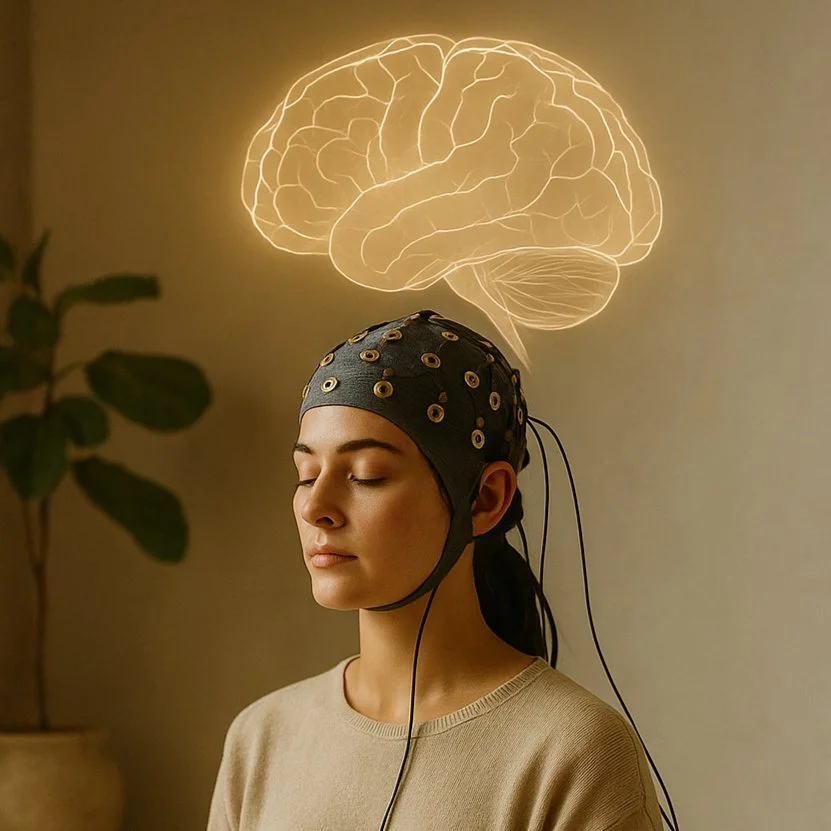Your brain deserves care
Your brain deserves care
Let your healing journey begin. Our services are designed to heal you from the inside and out.
Brain Mapping
Understanding how your brain functions is the first step toward lasting change. At NeuroHaven, we begin with a brain map, a noninvasive EEG-based assessment that provides a snapshot of your brain’s current patterns. It helps reveal how your brain is working in areas like focus, emotional regulation, stress response, sleep, and cognitive flow.
This is not a diagnosis and not a label. It is information. And that information tells a story. A brain map shows how your mind may be holding onto stress, fatigue, or outdated patterns. It gives us a starting point to create a training plan designed to support your goals and fit your life.
Whether you are seeking more clarity, calm, or performance, this process brings insight and direction to your personal journey.
Brain Mapping – Frequently Asked Questions
What is a brain map?
A brain map is a noninvasive assessment that measures brainwave activity using EEG technology. It helps identify patterns related to focus, stress response, sleep, and emotional regulation.
Is brain mapping safe?
Yes. Brain mapping is completely noninvasive and does not involve any electrical stimulation. It simply records your brain’s activity.
Can brain mapping help with anxiety or focus issues?
Brain mapping does not diagnose or treat conditions. However, it can reveal patterns often associated with things like high stress, trouble concentrating, or feeling overwhelmed. It gives us a starting point for personalized training.
Do I need to be still or perform tasks during the assessment?
You will be seated comfortably and asked to relax. There is no need to do anything special during the session.
Who is brain mapping for?
This is ideal for individuals who want insight into how their brain is functioning. It supports wellness, performance, and self-awareness.
Neurofeedback
Neurofeedback is a powerful science-backed method that trains your brain to move toward greater balance, flexibility, and resilience. During each session, you sit comfortably while sensors monitor your brainwave activity in real time. You do not have to do anything consciously. The system provides gentle feedback that guides your brain to adjust and find healthier patterns on its own.
With consistent training, neurofeedback can support emotional regulation, sharper focus, deeper sleep, and improved stress recovery. It is often used by high performers, creatives, and individuals navigating anxiety, burnout, or major transitions. This is not a treatment. It is a training process that supports the brain’s natural capacity to self-regulate.
At NeuroHaven, we pair this tool with presence, curiosity, and intention. The goal is not to fix or force anything. It is to help your brain return to its natural state of calm and clarity.
Neurofeedback – Frequently Asked Questions
What does a neurofeedback session look like?
You will sit comfortably while sensors measure your brainwave activity. As your brain shifts, the system provides subtle feedback through sound or visuals. You do not need to think or focus on anything in particular.
Is neurofeedback a treatment?
Neurofeedback is not a medical treatment. It is a training method that helps the brain improve flexibility, balance, and self-regulation over time.
Can this help me if I want to reduce anxiety without medication?
Many people who are looking for natural, drug-free ways to support calm, focus, and better sleep explore neurofeedback. While results vary, it can be a powerful tool to support nervous system resilience.
How many sessions will I need?
Everyone’s brain is different. Some people notice subtle shifts within a few sessions, while others benefit from ongoing training over time. A brain map helps guide your plan.
Is neurofeedback backed by science?
Yes. Neurofeedback has been studied for decades and is used by athletes, executives, and wellness professionals. It is grounded in neuroscience and used in both clinical and performance settings.



